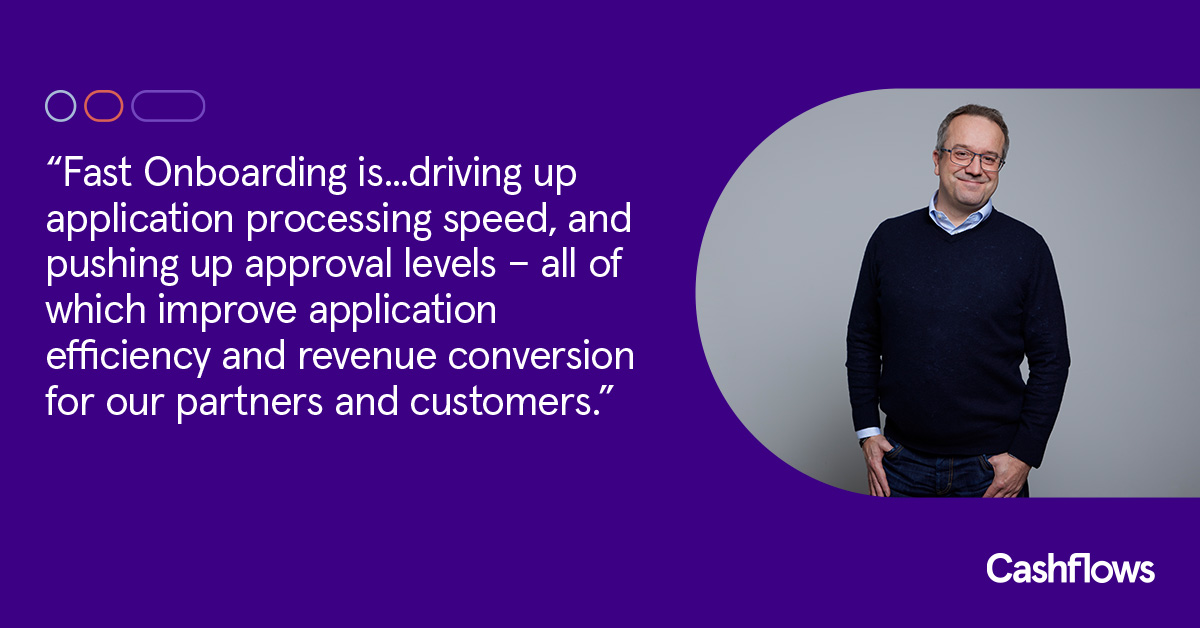Increasingly AI is being implemented to automate processes behind the scenes in businesses across every industry, improving customer experiences and boosting productivity. Here at Cashflows, we prioritise cutting-edge technology that drives real value and, therefore, looked to implement automation in the smartest way possible to ensure that the businesses we work with receive the positive benefits of increased efficiency without compromising our need for nuanced risk decision-making.
Having recently launched Fast Onboarding for our partners, which has made our onboarding process faster and easier for our partners and their clients, part of our risk process has been automated. As a payments provider and an acquiring bank, managing risk correctly is incredibly important to us so that we can deliver the best service possible to our customers and partners. This meant that automation had to be very carefully considered and applied, in order to leave room for complex cases that require a more considered approach that only a human (and one with an extensive knowledge of risk) could provide.
To find out more about the development of automated risk processes in Fast Onboarding, we spoke to our specialist, Richard Wilkins, Chief Risk Officer at Cashflows:
Why is risk so important at Cashflows?
Not only is risk important to us to be successful, but as a regulated financial service provider (FCA and DNB) and a licensed card schemes member, oversight from these bodies requires us to ensure we do not overly expose ourselves to risks we cannot afford, and which could bring payment services into disrepute or cause other businesses financial hardship. We, therefore, must understand the financial strength and the transactions of our customers throughout their lifecycle, ensuring that we maintain a diverse portfolio and reduce our vulnerability. This ensures that our customers are themselves protected.
How was automation balanced with the need for human input when developing Fast Onboarding?
As an acquirer, we’re presented with an array of different business types, and each of these presents a unique risk profile. We also operate in an environment where an array of providers can support elements of automation, but sometimes validation and assessment checks are only possible with human intervention. Deciding where that intervention is necessary is key, so we optimise the customer experience whilst not losing a fortune. Given this, automation balance is perpetual rather than a one-off event. Where we trigger manual intervention, as opposed to automation, is under constant review in line with loss levels, automation possibilities, application approval levels, business mix, and, of course, our speed of service. These factors help us to determine where our analyst talent is best utilised to add value.
Why is human decision making so important during onboarding, and what impact can it have on partners and merchants?
Firstly, it’s important to understand why a risk team is even needed. The short answer is that we have an array of compliance obligations to meet to protect the integrity of the payment system by ensuring we know our customers at all times. The Card Schemes themselves also have ongoing expectations and requirements which, along with regulation like the Consumer Credit Act, hold acquirers responsible for every transaction they process. As such, establishing a new business relationship and enabling them to submit financial transactions into the network requires us to be sure we know our customers and the kind of liabilities they are creating for us.
With the majority of our customers applying via partners, we don’t meet the customer nor see their place of business, so must trust the partner and their processes to ensure they have understood and correctly represented applications to us.
No one likes to invest time in an application that results in a decline. Fast Onboarding is allowing us to identify weaknesses in applications from our partner network, creating education opportunities that help them submit better applications to us, driving up application processing speed, and pushing up approval levels – all of which improve application efficiency and revenue conversion for our partners and customers.
What factors do you weigh up when making decisions on risk that AI cannot yet replace?
As clever as machine learning and AI is becoming, we have to be able to trust it, we have to recognise that the technology cost may be disproportionate in some instances, and we also have to recognise that AI is itself on a development path, and so will have its limitations, particularly around rationalising multiple data points. For me, an application contains an array of information that, in combination, sets a risk level, and as those risk levels increase, human intervention is needed to make the decision.
Through a variety of sources, tools, and processes, our analysts continuously validate the information they are being presented with to ensure it makes sense to them – querying, verifying, and validating where that’s not the case. For example, if we see an application for a newly established furniture business that is selling expensive items, is operating from a personal address, yet claims to be delivering furniture within 24hrs, and we can’t find either a website or any means of advertising, a human will consider those risk factors and challenge that information, as it seems implausible and contrary to their experience.
How does Fast Onboarding improve the efficiency of your team and of decision making, and what is the impact of this on customers?
Fast Onboarding allows for a consistent path for all applications, ensures applications are complete, reducing referrals, has automated many of the checks that were previously manual, aids consistent decision making, and is foundational in our being able to identify future improvement to optimise automation. The system also creates a clear auditable trail for every application, which is important on many levels. Fast Onboarding has meant that straightforward applications can now be approved much faster, with over 80% of our applications being processed within one working day.
What advice would you give to our customers and partners to ensure onboarding is as smooth as possible from a risk perspective?
Completing an application as fully as possible is a great first step, being careful to ensure the information shared is as accurate as possible to avoid unnecessary friction or inaccurate monitoring alerts from setting incorrect expectations with us at the outset.
It’s fundamental that our partners take the time to understand the kinds of businesses we can and cannot work with, as well as ensure they have understood what their client wants from their payments service to make sure their customer gets the right fit for them and that their application is successful.
Find out more about Fast Onboarding and how else Cashflows can help as payments partner.


